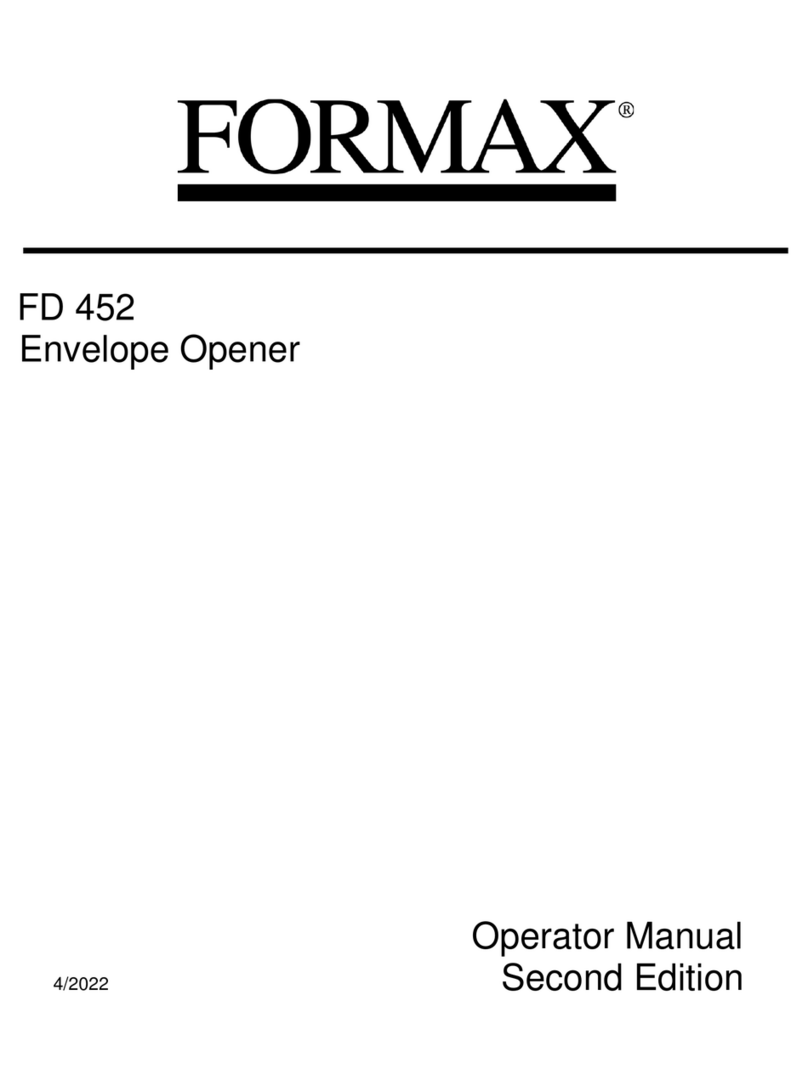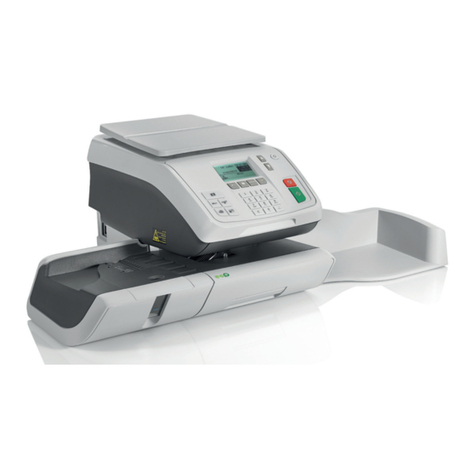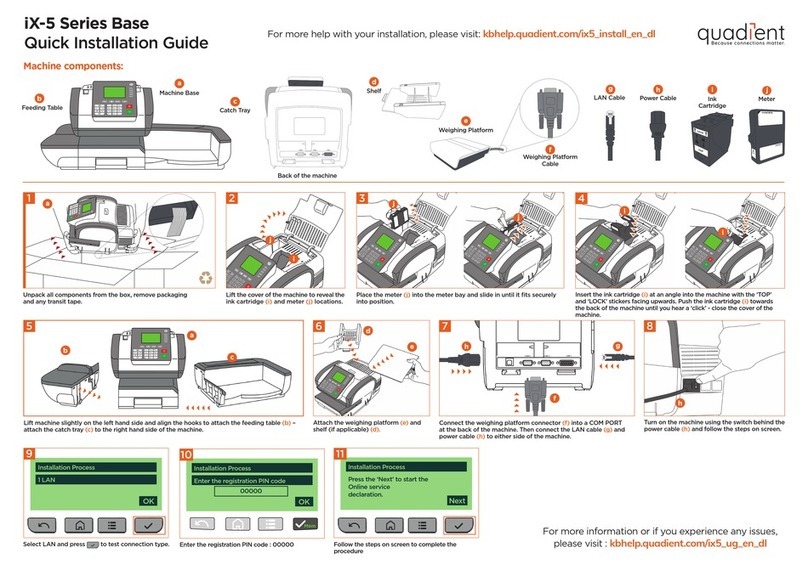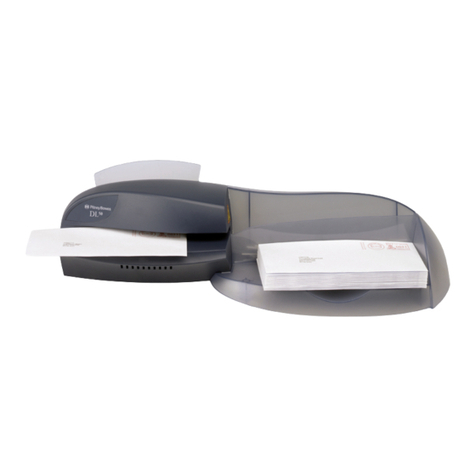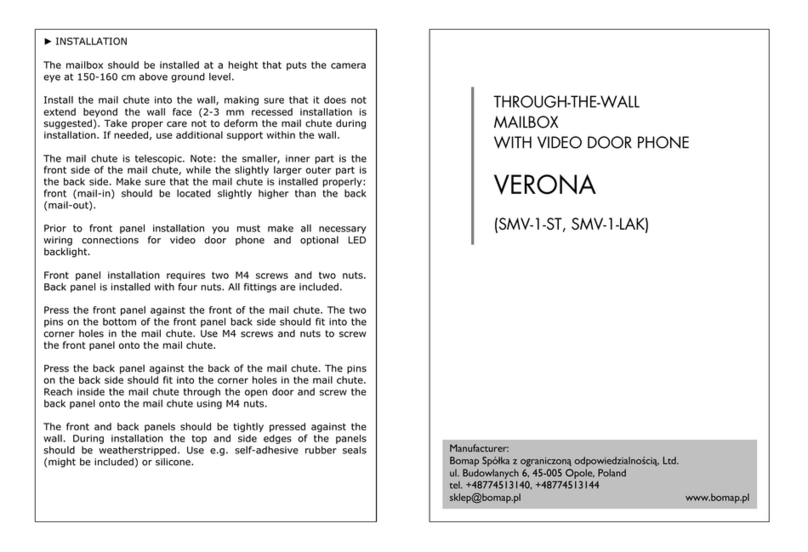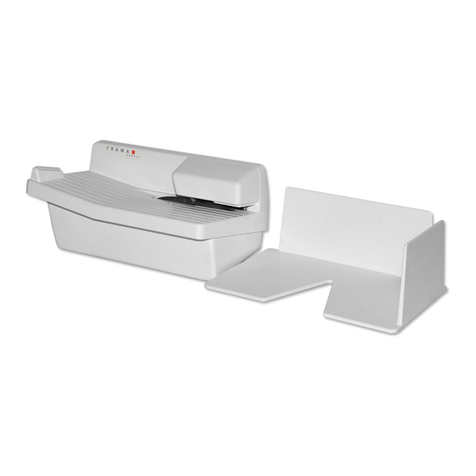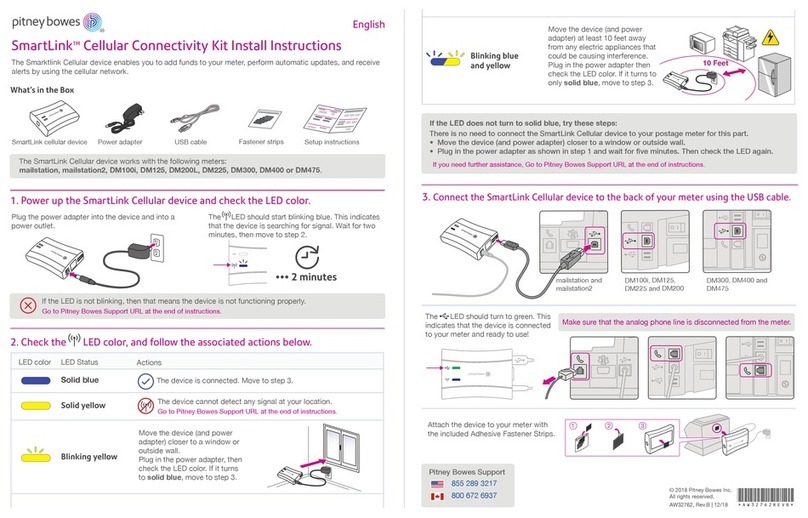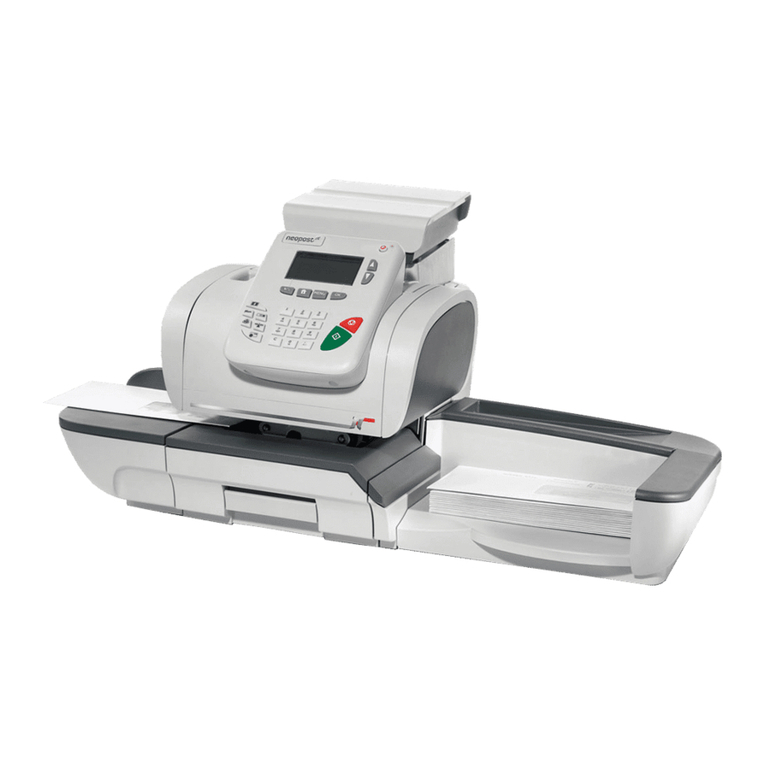Thiele Streamfeeder EFS Pro User manual

Manual
EFS Pro

Part Number 904537
© 2016 Thiele Technologies, Inc. - Streamfeeder. All rights reserved.
No part of this publication may be reproduced, photocopied, stored on a retrieval system, or transmitted without the
express written consent of Thiele Technologies, Inc. - Streamfeeder.
Thiele Technologies, Inc. - Streamfeeder
315 27th Avenue NE
Minneapolis, MN 55418 USA
Tel:(763) 502-0000
Fax:(763) 502-0100
e-Mail: service@streamfeeder.com
Web: www.streamfeeder.com
Printed in the USA.

i
EFS Pro Manual
Contents
Before You Begin.................................................................................ii
Message Conventions ................................................................................................................................. ii
Safety ......................................................................................................................................................... iii
Specications .....................................................................................iv
Section 1: About the Machine .......................................................1
Section 2: Set Up ............................................................................3
Section 3: How to Operate ...........................................................10
Section 4: Troubleshooting .........................................................13
Section 5: Inspection and Care ...................................................15
Section 6: Mechanical Components ...........................................23
Section 7: Electrical Diagrams ....................................................43
Envelope Sealing System Parts Manual..........................................46

ii EFS Pro Manual
Message
Conventions
DANGER signies an action or specic equipment area that can result in
serious injury or death if proper precautions are not taken.
WARNING signies an action or specic equipment area that can result in
personal injury if proper precautions are not taken.
CAUTION signies an action or specic equipment area that can result in
equipment damage if proper precautions are not taken.
ELECTRICAL DANGER signies an action or specic equipment area that
can result in personal injury or death from an electrical hazard if proper pre-
cautions are not taken.
Before You Begin
TECHNICIAN
OPERATOR
TIP signies information that is provided to help minimize problems in the
installation or operation of the feeder.
NOTE provides useful additional information that the installer or operator
should be aware of to perform a certain task.
CHECK signies an action that should be reviewed by the operator before
proceeding.
IMPORTANT alerts the installer or operator to actions that can potentially
lead to problems or equipment damage if instructions are not followed prop-
erly.
TECHNICIAN indicates that a qualied technician should be alerted to the
corresponding tasks and information.
OPERATOR indicates that an operator should be alerted to the corresponding
tasks and information.
WARNING LABELS afxed to this product signify an action or specic
equipment area that can result in serious injury or death if proper precautions
are not taken.

iii
EFS Pro Manual
Make sure you thoroughly read this section to become familiar with
all the safety issues relating to the safe operation of this product.
Please read all of the warnings that follow to avoid possible injury.
Although Thiele-Streamfeeder has made every effort to incorporate
safety features in the design of this feeder, there are residual risks that
an installer or operator should be aware of to prevent personal injury.
Please read all of the cautions that follow to prevent damage to this
product. This product is built with the highest quality materials.
However, damage can occur if the system is not operated and cared for
within design guidelines as recommended by Thiele-Streamfeeder.
To insure proper machine operation make sure that all the safety de-
vices are installed properly and functioning. If the feeder has the me-
dia sensor on the side guides insure that these are properly installed.
Do not attempt to defeat a safety interlock or safety feature.
Equipment interior contains incoming 115 or 230VAC electrical
power. Bodily contact with these high voltages can cause electro-
cution, which can result in serious injury or death.
safetY
Danger
TECHNICIAN
OPERATOR

iv EFS Pro Manual
speCifiCations
Maximum Product Size: ............................. 10 in. W x 13 in. L (254 mm x 330 mm)*
Minimum Product Size: ............................. #9 envelope, 3-7/8 in. W x 8-7/8 in. L (98 mm x 225 mm)*
Min/Max Product Thickness: .................... .003 in. to .25 in. (.076 mm - 6.35 mm)
Belt Speed: ................................................... 1,800 in/min (46 m/min)
Utilities: ........................................................ 115vac, 50/60Hz, 3A
Weight: ......................................................... 90 lbs. (41 kg)
Warranty: .................................................... One year limited
*Short edge leading

v
EFS Pro Manual

1EFS Pro Manual
1About the Machine
Main Assemblies
Moistening
Device
Hold
Down
Counter
Back
Wedge Side
Guide
Separator
Table
Top
On/Off
Switch
Feed/Discharge
Carriages
Sealing
Roller
Assembly
Catch
Tray
Variable
Speed
Control
The EFS Pro is an automatic envelope ap sealer, reducing the time
and mess of manually sealing envelopes. From a #9 envelope to a
10x13, and with various aps, the EFS Pro will provide consistent
feeding and ap sealing quality. Convenient and easy to set-up, along
with quick changeover from one job to another.
Familiarizing yourself with names and locations of feeder parts and
adjustments will help to prepare you for initial setup.

2
EFS Pro Manual
Main Assemblies Feature Descriptions
Feature Description
Moistening Device Assembly is used to separate the ap from the envelope, allowing the ap
portion of the envelope to pass and to come in contact with moistening brush.
The assembly also can be manually adjusted with the use of a lever to allow
envelopes to bypass the opening mechanism.
Sealing Roller Assembly Final roller assembly (downstream from moistening device). Applies pressure
on moistened and sealed envelope, securing ap closure to envelope.
Counter Digital and resettable with the use of the reset button.
Variable Speed Control Adjustment of this potentiometer type control will change the feed speed of the
unit. Turning the knob counter-clockwise decreases speed; clockwise increas-
es speed.
On/Off Switch Rocker style switch toggles AC power On or Off.
Table Top One piece shell for mounting of all sub-assemblies and components.
Back Wedge Lifts the envelopes to keep them off the table top, reduces excessive contact
with the feed belts, and helps push the envelopes against the curvature of the
separator assembly.
Side Guide Allows lateral adjustment from side for different size envelopes.
Separator Single separator mounted above the carriage housing the feed belts. This
device provides a curvature to help preshingle stacked envelopes. When
properly adjusted, a clearance is created to help singulate and feed envelopes.
Non-Adjust Hold Down Provides the friction and motion necessary to pull envelopess away from the
separator assembly. Positioned above discharge belts. Assists in creating gap
between envelopes in discharge section.
Removable Feed/Discharge
Carriages
Houses the feed belts which provides the friction and motion necessary to pull
individual envelopes from the bottom of the stack and through the separator
assembly. Easy to remove for feed belt replacement.

3EFS Pro Manual
2Set Up
Prepare the machine for operation. To do so, set up the envelopes you
are going to be feeding. Do a test run with the envelopes to verify it is
set correctly before you begin cycling the feeder.
You will have to perform this procedure for envelopes you plan to feed.
When performing initial feeder adjustments
prior to operation, always make sure you turn
Off the main power switch and disconnect all
equipment from the electrical power source.
Failure to do so can expose you to a potential
start-up and moving parts which can cause
serious injury.
Do not attempt to make any adjustments while
the feeder and machine of application are
running. Failure to do so can expose you to
moving parts which can cause serious injury.
Do not wear loose clothing when operating the
feeder.
Avoid making adjustments with loose or
unsecured parts. This can potentially damage
parts.
STEP 1:
Separator Adjustment
Review
The separator assembly provides the curvature to help preshingle
envelopes and the proper gap to help the feed belts pull envelopes
through the separator assembly area — one at a time. The downward
pressure (or weight) of the stack in the hopper will provide the force to
help push the envelopes against the curvature of the separator assem-
bly, and help it contact the feed belts. This preshingling will allow the
separator assembly to efciently separate (and singulate) envelopes.
To achieve the optimum separation, you have to use the adjustment
knob to either increase (clockwise) or decrease (counterclockwise) the
gap between the separator assembly and the feed belts.
Objective
Adjust the separator assembly for minimum gap, with minimum
pressure on the envelopes. Your objective is to adjust the clearance so
that a single envelope passes without resistance. The optimum setting
should be a gap adjustment of 1.5 thickness of an envelope.
Keep in mind the separator assembly works with
the wedge to provide the proper lift, curvature of
the envelopes, and proper belt/envelopes contact
to separate and feed one piece at a time.
Hopper refers to the space where the envelope is
stacked (made up of the side guides).
Feeding problems will occur with either too
much envelopes in the hopper, or too large a
gap between the separator assembly and the
envelopes.
The adjustments you must make (in order) are as follows:
1: Separator adjustment
2: Side guide adjustment
3: Back wedge adjustment
4: Manual test to verify
5: Envelope Moistening Device Setup

4
EFS Pro Manual
Excessive lowering of the separator assembly can damage envelopes
or lead to premature wear of the O-rings or feed belts.
A wider gap between envelopes and belt provides
the highest tolerance for curled and bent edges.
Feeding problems will occur with either too
many envelopes in the hopper, or too large a
gap between the separator assembly and the
envelope.
STEP 1:
Separator Adjustment
(continued)
1. Slide a single envelope between the feed belt and the separator.
2. Rotate the separator adjustment knob either up or down until the
envelopes can be pulled from under the separator assembly with a
slight amount of drag.
3. Repeat the drag tests and adjust as needed to achieve acceptable
clearance.
Separator
Adjustment
Knob

5EFS Pro Manual
STEP 2:
Side Guide Adjustment
1. Loosen the side guide knob. This will allow you to move the side
guide from side to side.
Register the envelopes
to be run on the wide
belt and position against
left side frame
Loosen knob
Move side guide
laterally
2. Register the envelopes to be run on the wide belt and position
against left side frame.
3. Place a handful of pre-shingled envelopes in the hopper and
against the separator.
4. Test run to assure proper feeding and singulation.
5. Tighten the side guide lock knob to secure the position.

6
EFS Pro Manual
Moving the back wedge too far forward to the
separator assembly can create a pinch point
between the tip of the triangle wedges and the
envelopes.
STEP 3:
Back Wedge Adjustment
Procedure
Adjust the back wedge for proper positioning following these steps:
1. Grasp a handful of envelopes, approximately 2 to 2.5 in. (5 to
6 cm) thick, and preshingle the edges with your thumb.
2. Place the pre-shingled envelopes in the hopper so that the
front edges rest against the curvature of the separator assem-
bly. The envelopes should be loaded ap side down with the
hinge portion against the feeder side frame.
3. Loosen the wedge adjustment lock knob.
4. Move the wedge back and forth until the bottom envelope is
not touching the table top. (see photo)
5. Make sure the wedge assembly is parallel with the edge of the
envelopes stack. Adjust as required and tighten the lock knob.
6. Wedge adjustments for wider envelopes can be achieved with
lateral adjustment. (See photo below)
Keep in mind that the back wedge works with
the separator assembly to provide the proper
lift, curvature of the envelopes, and proper belt/
envelopes contact to separate and feed one sheet
at a time.
There are a number of feeding problems which
can be solved by simply adjusting the back wedge
to different positions. Some of these problems
include double feeds, skewing, twisting, poor
singulation and jamming at the separator
assembly area.

7EFS Pro Manual
STEP 4:
Manual Test to Verify
STEP 5:
Envelope Moistening
Device Setup
Now that you have made all the necessary adjustments for operation,
it is recommended that you verify envelopes singulation and separa-
tion at the feeder for your particular application. Before you power-up
and run your machine with a full hopper, manually feed several pieces
of envelopes through the separator assembly area.
Prepare your test by loading the hopper with approximately 2 to 2.5 in.
(5 to 6 cm) of envelopes. Make sure you preshingle the stack so that
envelopes rests against the curvature of the separator assembly.
1. With the power off, manually feed several pieces of envelopes
slowly through the separator assembly area.
2. Observe how individual envelopess enter and exit the separa-
tor assembly area. Remember, a properly set gap will allow
each new piece to enter at about the center line of the cylinder
while the bottom piece is exiting the separator assembly area.
3. If feeding doubles, then move the wedge in towards the sepa-
rator assembly. Test again.
4. If pieces are overlapping excessively or, if the machine is
feeding doubles, then reduce the gap slightly by moving the
separator(s) adjustment knob about 1/8 turn counter-clock-
wise. Test again.
5. As envelopes moves through the hold-down area, check for
any skewing or jamming. Also check for damage to the enve-
lopes.
6. If this or other feeding problems still persist (slipping, skew-
ing, jamming), then review all the adjustment procedures in
“Preparing for Operation”.
Remove cap from bottle and ll with either water or ap sealing solu-
tion. Replace cap tight to prevent air leaks which could result in over-
lling and leaking within reservoir. Quickly tip bottle upside-down
and insert into top of reservoir until rmly latched.
If the separator assembly is too tight, the feeder
will have difculty pulling the envelopes through
the separator assembly area. This will cause
“missed” feeds.
Moving the back wedge too far forward to the
separator assembly can create a pinch point
between the tip of the triangle wedges and
the envelopes. If moving the back wedge in is
not effective, then an optional wedge may be
required.
For certain types of envelopes, you may have to
position the envelopes “off-center” to prevent
any skewing affect.

8
EFS Pro Manual
The moistening device runs in two different modes. The selection of
these two modes is achieved with the use of a lever. One is what is
called the production or ap opening mode. In this mode the envelope
is fed ap down with the hinge portion of the envelope up against the
left side frame of unit (also used for left side guide and registration).
Production or ap opening mode
When the envelope passes through the moistening device, a divert tab
(shoe) located above the envelope applies slight pressure from the top
side of the envelope. When this pressure is applied, the envelope ap
is deected down and under a knife device that leads to the sealing
brush. With the ap somewhat open and away from the body of the
envelope, the sealing brush is allowed to apply moisture to the ap.
STEP 5:
Envelope Moistening
Device Setup
(continued)
The second mode is the by-pass mode. The divert tab or shoe is in the
retracted or up position, not in the direct path of envelopes as they
pass over the moistening device.
Bypass mode

9EFS Pro Manual
“Thin/Thick” adjustment bracket in the down
position (factory) should be used for running
thinner stuffed envelopes.
“Thin/Thick” adjustment bracket in the up
position (factory) should be used for running
thicker stuffed envelopes.
STEP 5:
Envelope Moistening
Device Setup
(continued)
Additional adjustment may be needed on the divert tab when running
thicker envelopes (up to ¼” maximum).
With the use of a 5/64” Allen Wrench you can reposition the adjust-
ment bracket to the up position. This adjustment should be completed
when running thicker envelopes.
“Thin/Thick” adjustment bracket in the
down position (factory).
“Thin/Thick” adjustment bracket in the
up position (factory).

10
EFS Pro Manual
3How to Operate
Sequence of
Operation
Successful power-up and operation is assured if you apply the follow-
ing sequence of steps:
1: Loading envelopes in the hopper
2: Determining stack height
3: Powering On feeder
4: Setting/adjusting speed
5: Final check
STEP 1:
Loading Envelopes
in the Hopper
Preshingling prevents multiple pieces from
jamming under the separator assembly at startup.
1. Start by preshingling by hand a small stack of envelopes so
that it conforms to the curvature of the separator assembly.
Push in gently to make sure lead edges touch the separator as-
sembly and front edges of the pre-separator bars.
2. At the back wedge, notice how it helps lift the trailing edges
of the envelopes off the table top and feed belts. Also notice
how the lifting helps to push the preshingled edges against the
curvature of the separator assembly.
This section provides a sequence of operation for the feeder. It also
provides information for clearing a jam and for shutdown.
STEP 2:
Determining Stack
Height
1. Gradually add more envelopes to the hopper after the initial
stack is formed around the separator assembly. The stack
height will have a preferred minimum and a maximum, you
will have to experiment to determine effective range of height.
2. Make sure the envelopes are loaded in the hopper as straight
as possible. Before adding to hopper, “jog” each handful of
envelopes on a at surface to make sure lead edges are as
even as possible. As you add each handful, gently push in
each stack so that lead edges rest rmly against front of side
guides. "Fanning" the stack prior to loading it into the hopper
may reduce double feeds.
Stack height affects the downward pressure on
the feed belts. Greater downward pressure can
increase the chances for double feeds.

11 EFS Pro Manual
STEP 4:
Setting/Adjusting Speed
1. Set the variable speed control to the lowest speed (counter-
clockwise). Feeder motor stops if turned completely counter-
clockwise.
2. Start by slowly turning the control clockwise to gradually
increase feeder speed to coincide with the desired speed.
Turn the feeder power On by pushing the horizontal line (—) at the
Power On/Off rocker switch.
STEP 3:
Powering On Feeder
Make sure:
• Proper separation is occurring at separator assembly area.
• Envelopes is not skewing.
• Effective preshingling is occurring at curvature of separator assem-
bly.
• Envelopes is not being damaged during cycling.
• Feeder is secured and will not move during operation.
STEP 5:
Final Check

12
EFS Pro Manual
If a jam occurs during operation, follow these steps:
1. Turn the feeder power Off by pushing the circle (O) at the
rocker Power On/Off rocker switch.
2. Remove jammed envelopes from feeder. While doing so, try
to determine the cause of the jam (see “Troubleshooting”).
3. Verify whether any adjustments are loose. If so, refer to “Pre-
paring for Operation”, for proper adjustment procedures.
4. Turn the feeder power back On by pushing the horizontal line
(—) at the Power On/Off rocker switch.
Should you not be using the feeder for long periods of time, follow
these steps to ensure safe and secure storage:
1. Turn the feeder power Off by pushing the circle (O) at the
rocker Power On/Off rocker switch.
2. Disconnect the feeder power cord from the AC power source.
If installed, disconnect external run input from feeder control
panel.
3. Remove water bottle.
4. Cover the feeder with a cloth or plastic tarp to prevent dust.
Shutdown
Clearing a Jam

13 EFS Pro Manual
4Troubleshooting
This table is intended to provide you with quick solutions to the more common day-to-day problems you may
encounter.
Problem
No AC power to
feeder
1. On/Off switch in "Off" (or "O" position).
2. Power cord loose or not plugged into
outlet (or AC power source).
3. Female end of power cable loose or not
plugged into AC power inlet at rear of
feeder.
1.
Separator assembly improperly adjusted
(possibly more than one envelope thickness).
2. Back wedge improperly adjusted.
3. Worn O-rings (or angled edge).
4. Envelopes interlocking.
5. Static buildup.
1. Envelopes stack height is too low when
stack height is down, resulting in reduc-
tion of down pressure.
2. Binding in side guides.
3. Loss of friction on feed belts.
4. Sheet adhesion or interlocking between
the bottom and next envelope.
Move switch to "On" (or "—" position).
Check and secure power cord at AC
outlet.
Check and secure cord at AC power
inlet at rear of machine.
Review separator adjustment proce-
dure.
Review back wedge adjustment proce-
dure.
Rotate O-rings. If applicable, replace
angled edge. If wear is excessive, con-
sult with a qualied technician.
Check envelopes and source.
Check envelopes and source.
Review envelopes loading procedure.
Adjust side guides further apart to allow
freedom of movement between enve-
lopes.
Refer to "Cleaning Feed and Discharge
Belts".
Review envelopes loading procedure
and back wedge adjustment procedure.
Feeding doubles
Feed belts are op-
erating, but enve-
lopes not feeding
Cause Solution
Table of contents
Popular Postal Equipment manuals by other brands

Neopost
Neopost ij25 user guide
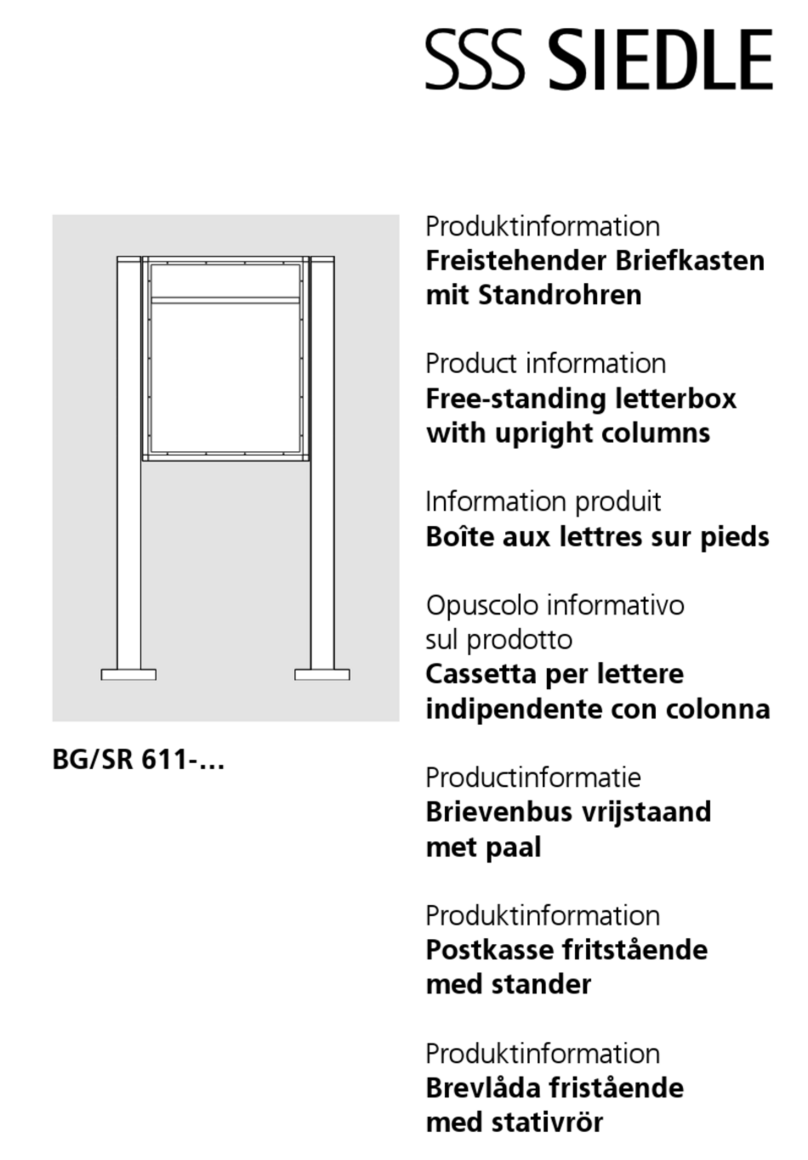
SSS Siedle
SSS Siedle BG/SR 611 Series Product information
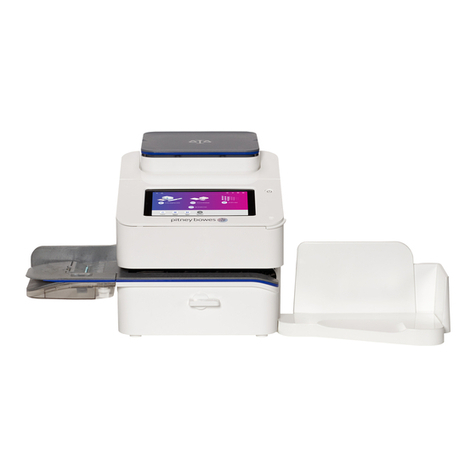
Pitney Bowes
Pitney Bowes SendPro C Operator's guide
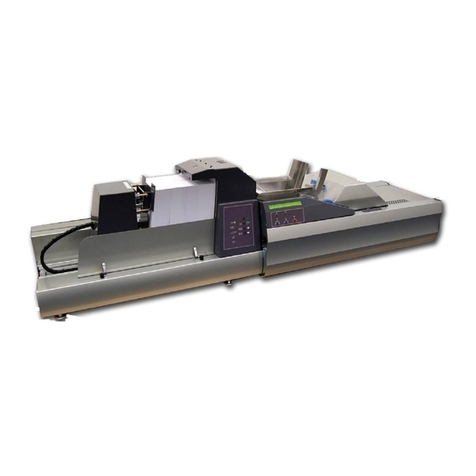
Pitney Bowes
Pitney Bowes F731 Operator's guide
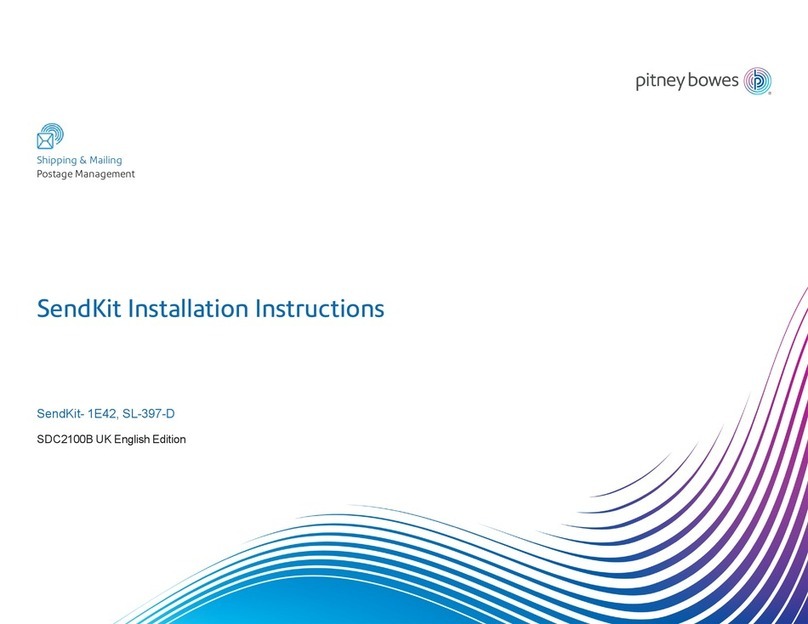
Pitney Bowes
Pitney Bowes 1E42/W1110 SendKit installation instructions
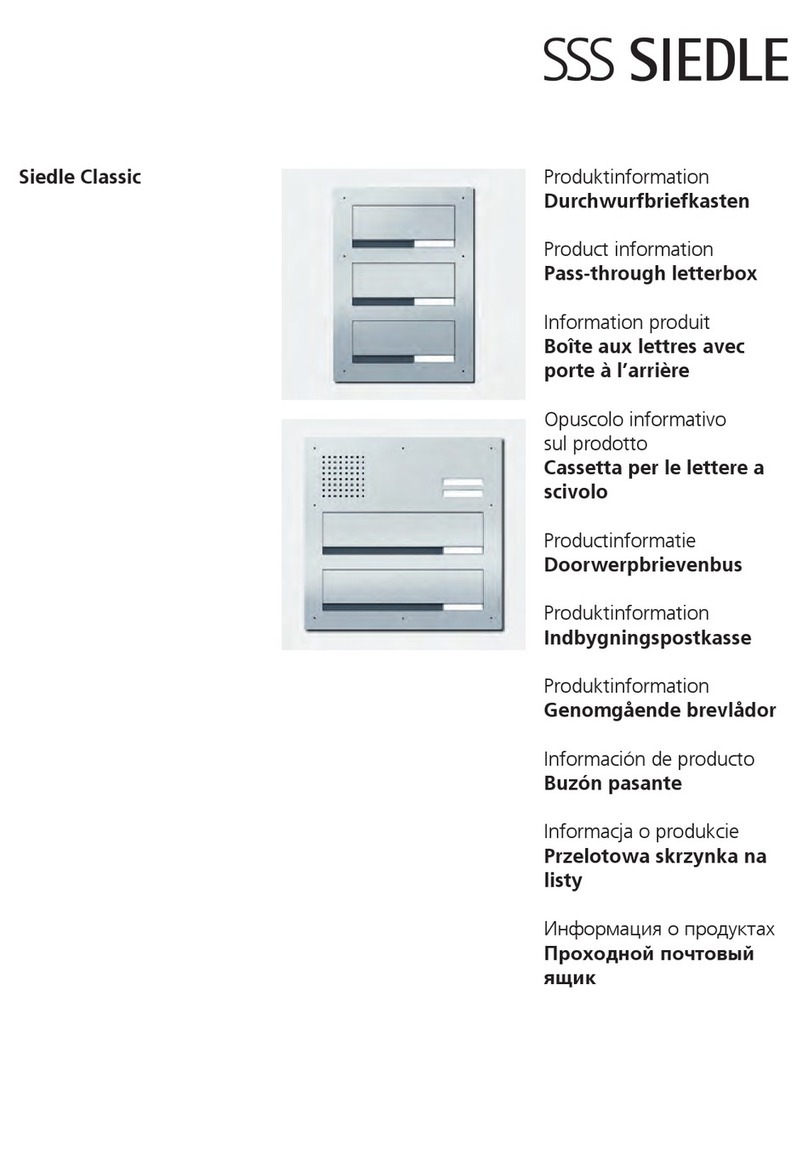
SSS Siedle
SSS Siedle CLASSIC Product information
